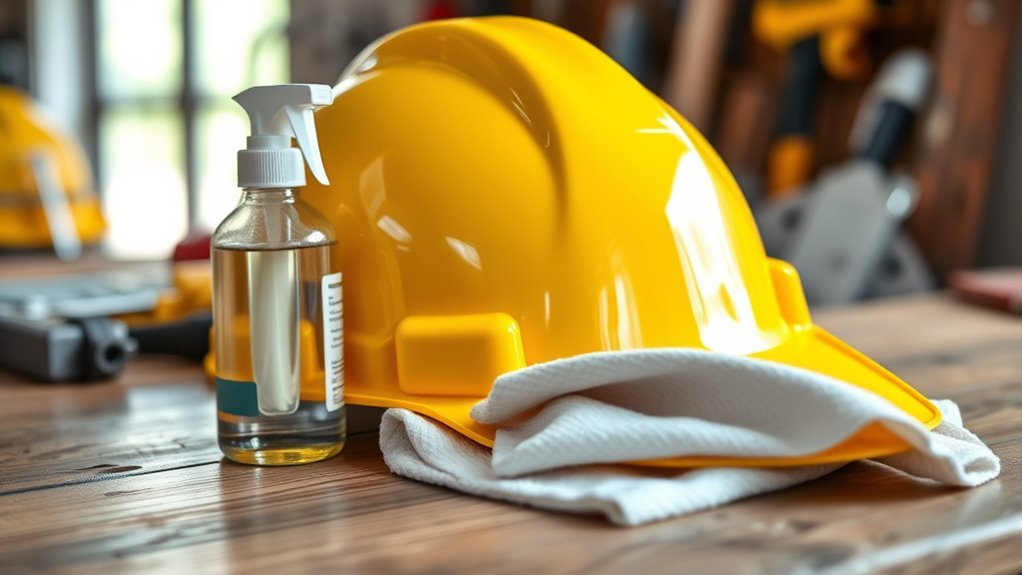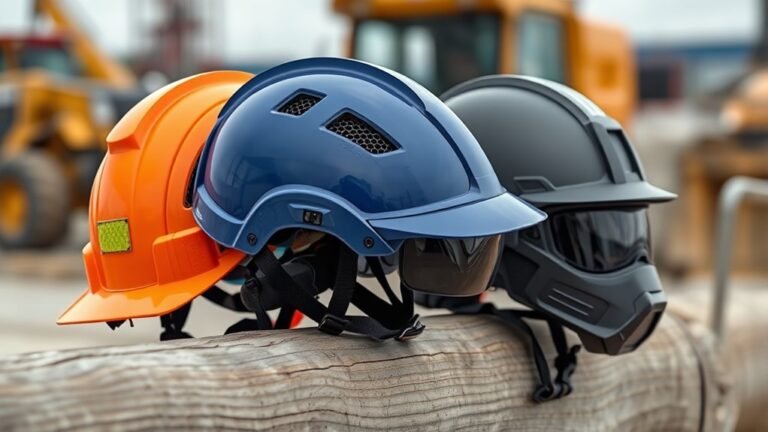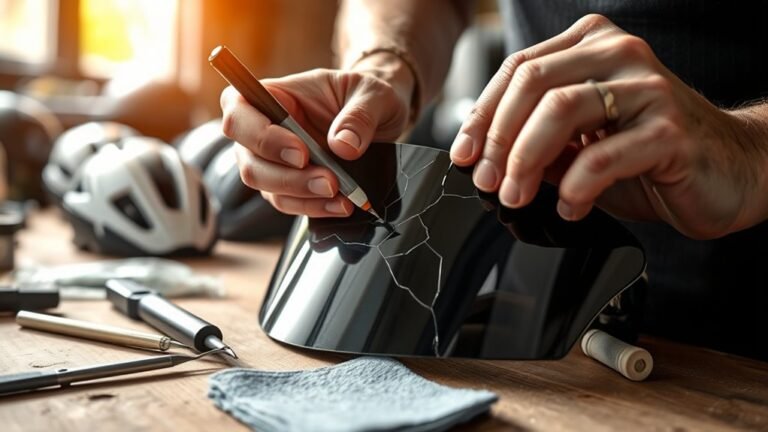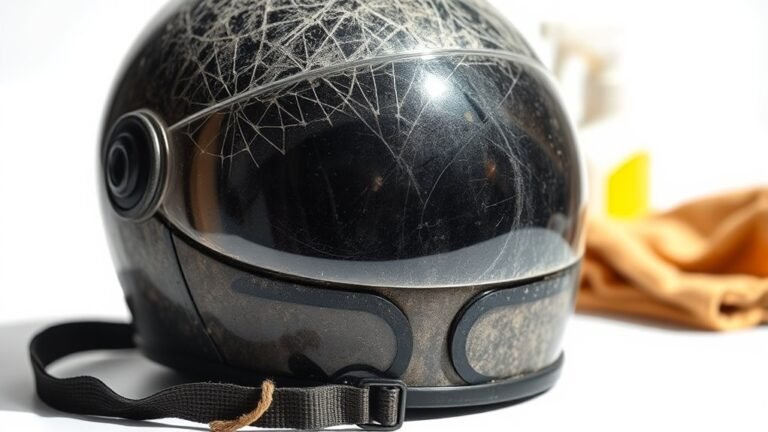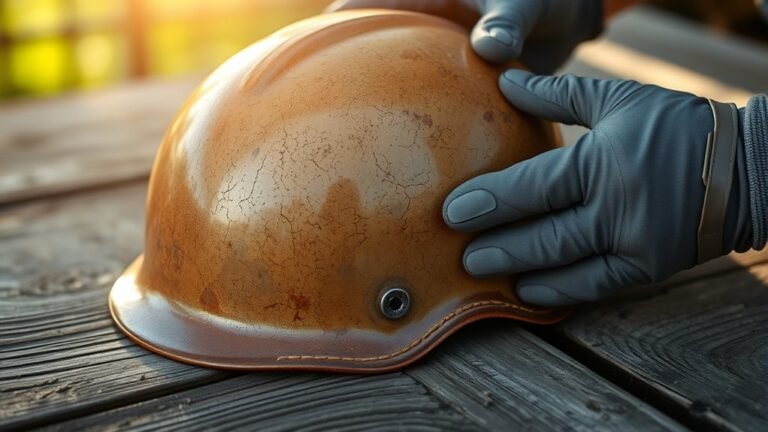How to Maintain Your Hard Hat for Maximum Protection
To maintain your hard hat for maximum protection, regularly inspect it for cracks, dents, or worn suspension systems. Clean it according to manufacturer guidelines to prevent dirt buildup and guarantee comfort. Store your hard hat in a cool, dry place away from sunlight, and avoid heavy objects on top. Replace worn or damaged components, and be aware of the hard hat’s lifespan. Understanding these elements is vital for safety; learn more about best practices for your hard hat.
Understanding the Components of a Hard Hat

A hard hat is more than just a protective accessory; it’s a critical piece of safety equipment designed to shield your head from impact and penetration hazards. Understanding the materials used in hard hats is essential for ensuring peak performance. Most hard hats are made from high-density polyethylene (HDPE) or fiberglass, both known for their durability and impact resistance. HDPE offers lightweight protection, while fiberglass provides superior strength in harsher environments. The inner suspension system, often made of nylon or polyester, helps absorb shock and keeps the hat secure during use. By familiarizing yourself with these components, you can select a hard hat that meets your specific needs, giving you the confidence to work freely while maintaining safety on the job site.
Regular Inspections: Checking for Damage
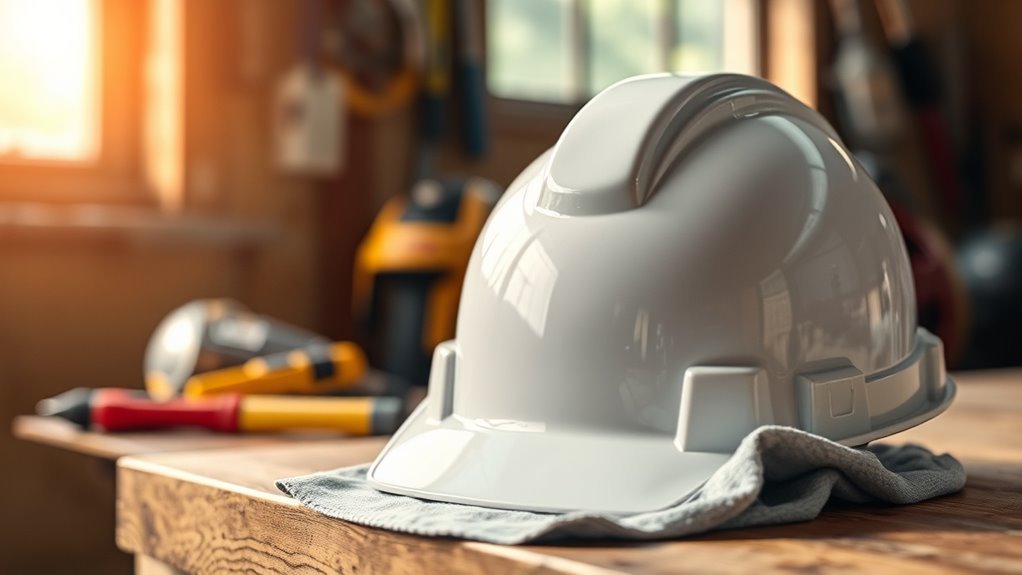
Regular inspections of your hard hat are essential for ensuring your safety on the job. You need to perform a visual damage assessment, check the expiration date, and follow proper cleaning and maintenance procedures. By doing so, you can identify potential issues before they compromise your protection.
Visual Damage Assessment
Since hard hats are your first line of defense against head injuries, conducting regular visual damage assessments is essential to confirm their continued effectiveness. Use visual inspection techniques to meticulously examine your hard hat for any damage indicators. Look for cracks, dents, or scratches on the outer shell, as these can compromise structural integrity. Don’t forget to check the suspension system; frayed straps or broken components can lead to a poor fit, reducing protection. Pay attention to any discoloration or warping, which may signal degradation from exposure to sunlight or chemicals. By routinely engaging in this thorough assessment, you confirm your hard hat remains reliable, empowering you to work confidently and safely in any environment.
Expiration Date Check
Alongside visual damage assessments, checking the expiration date of your hard hat is essential to guaranteeing its effectiveness. Every hard hat has a recommended lifespan, which varies by manufacturer and material. The expiration date significance lies in its role in maintaining protection during hazardous work. Once a hard hat reaches its expiration, its structural integrity may diminish, risking your safety. Regularly inspect the date to avoid using outdated gear that compromises hard hat longevity. If you find your hard hat is nearing or past its expiration, replace it promptly. Investing in a new hard hat not only guarantees compliance with safety standards but also empowers you to perform your tasks with confidence, knowing you’re shielded from potential dangers.
Cleaning and Maintenance Tips
Inspecting your hard hat at least once a month is essential for guaranteeing its continued effectiveness and safety. Regular inspections help you identify potential damage that could compromise your protection. Pay attention to the following aspects during your checks:
- Cracks or dents: Examine hard hat materials for any signs of wear and tear.
- Suspension system: Confirm it’s securely in place and free from fraying or damage.
- Interior cleanliness: Remove dirt and sweat buildup to maintain hygiene and comfort.
Cleaning Your Hard Hat Properly
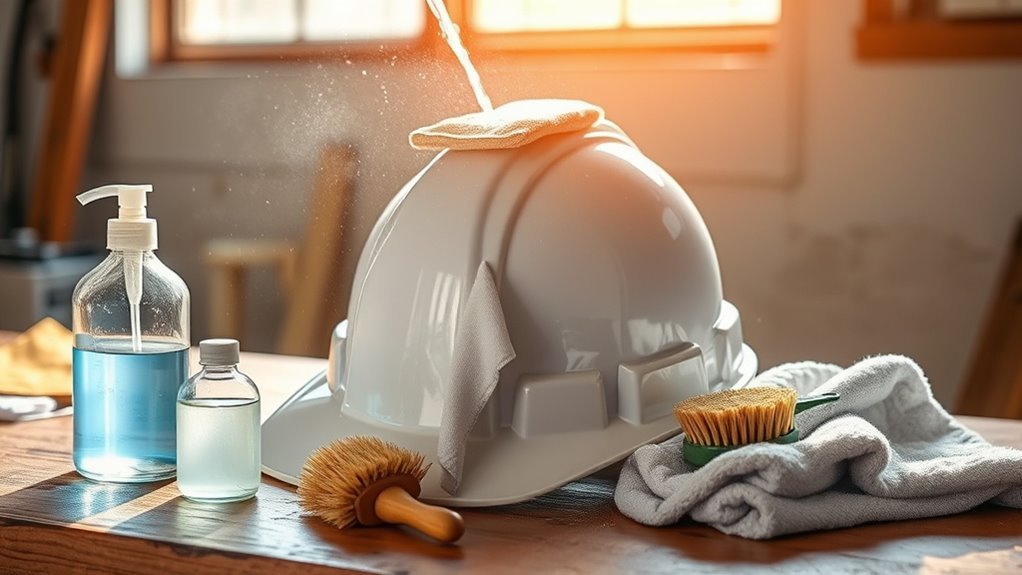
Cleaning your hard hat properly is essential for ensuring its longevity and effectiveness. Different hard hat materials may require specific care, so always check the manufacturer’s guidelines. Typically, a mild soap solution works best for cleaning. Here’s a quick reference table for your cleaning routine:
| Hard Hat Material | Recommended Cleaning Solutions |
|---|---|
| Polycarbonate | Mild soap and water |
| Fiberglass | Isopropyl alcohol |
| ABS | Non-abrasive detergent |
| HDPE | Warm, soapy water |
| EPS | Water with a soft cloth |
After cleaning, rinse thoroughly and allow it to air dry. Avoid harsh chemicals, as they can compromise the integrity of your hard hat. Regular cleaning keeps your hard hat in top shape, ensuring maximum protection on the job.
Storing Your Hard Hat Correctly
When storing your hard hat, it’s essential to choose an ideal environment that’s cool and dry, away from direct sunlight. This helps prevent deterioration of the materials. Additionally, avoid placing heavy objects on top of it to prevent any physical damage that could compromise its protective capabilities.
Ideal Storage Environment
To guarantee your hard hat remains in ideal condition, it’s important to store it in an environment that protects it from extreme temperatures and direct sunlight. The right storage location plays a significant role in maintaining its integrity. Here are some tips for setting up an ideal storage environment:
- Temperature Control: Keep your hard hat in a climate-controlled area, ideally between 50°F and 100°F.
- Avoid Humidity: Store it in a dry place to prevent mold and degradation of materials.
- Shield from Sunlight: Use a storage box or hang it in a shaded area to avoid UV exposure.
Avoiding Physical Damage
While it may seem straightforward, properly storing your hard hat is crucial to avoiding physical damage that can compromise its effectiveness. Always store your hard hat in a cool, dry place, away from direct sunlight, which can weaken its materials and reduce impact resistance. Avoid placing heavy items on top of it, as this can create dents or deformities. When not in use, consider using a protective bag or box for additional hard hat care. Hanging your hard hat can also help maintain its shape. Remember, a well-cared-for hard hat not only extends its lifespan but guarantees maximum protection. Protecting your hard hat today means safeguarding your safety tomorrow.
Replacing Worn or Damaged Parts
Although your hard hat is designed to withstand significant wear and tear, it’s crucial to regularly check for worn or damaged parts that could compromise its effectiveness. Adhering to replacement schedules helps maintain safety and functionality.
Here are key components to inspect and replace as needed:
- Suspension System: Confirm it’s intact and securely attached. A damaged suspension can reduce protection.
- Chin Strap: Replace if frayed or broken to guarantee your hat stays in place.
- Shell: Look for cracks or dents; a compromised shell can lead to failure during impacts.
When replacing parts, always consider part compatibility to guarantee peak performance. By staying proactive, you embrace the freedom of working safely, knowing your hard hat is equipped to protect you.
Avoiding Chemical Exposure
Chemical exposure poses a significant risk to the integrity of your hard hat, making it essential to minimize contact with harmful substances. To protect your hard hat, consider using models made from chemical resistance materials, which can withstand various hazardous chemicals. Familiarize yourself with exposure prevention methods, such as keeping your hard hat away from areas where chemicals are in use. If you work in environments with potential chemical hazards, always wear a hard hat that meets industry standards for chemical protection. Regularly inspect your hard hat for signs of degradation, as chemicals can weaken its structure over time. By taking these precautions, you’re ensuring your hard hat remains a reliable source of protection, empowering you to focus on your work with confidence.
Staying Aware of Hard Hat Lifespan
How often do you think about the lifespan of your hard hat? Staying aware of its durability is essential for ensuring your safety on the job. Hard hats don’t last forever, and knowing when to replace yours can make a significant difference.
Regularly consider your hard hat’s lifespan; its durability is crucial for your safety on the job.
Consider these factors to assess your hard hat’s lifespan:
- Manufacturer’s Guidelines: Always check the safety gear lifespan recommended by the manufacturer.
- Visible Damage: Inspect for cracks, dents, or any signs of wear that may compromise its integrity.
- Age: Generally, hard hats should be replaced every 2-5 years, depending on usage and exposure conditions.
Keeping Your Hard Hat Free From Accessories
Have you ever considered how accessories can compromise your hard hat’s effectiveness? While it might seem tempting to personalize your hard hat with various hard hat accessories, these additions can interfere with its protective capabilities. Items like stickers, lights, or attachments can obstruct ventilation, weaken the shell, or even create points of failure during an impact. To guarantee safety compliance, it’s crucial to keep your hard hat clear of anything that isn’t manufacturer-approved. Remember, your hard hat’s primary function is to protect you from head injuries. By avoiding unnecessary accessories, you maintain the integrity of your hard hat and enhance your safety on the job. Prioritizing protection over personalization is the key to staying safe in hazardous environments.
Educating Yourself on Safety Standards
Why is it essential to familiarize yourself with safety standards when it comes to hard hats? Understanding these regulations not only protects you but also empowers you to advocate for your safety and that of your colleagues. By staying informed about safety regulations and industry standards, you can guarantee that your hard hat meets the necessary criteria for maximum protection.
- Research the latest safety regulations specific to your industry.
- Regularly review manufacturer guidelines for hard hat maintenance.
- Attend safety training sessions to stay updated on best practices.
Frequently Asked Questions
Can Hard Hats Be Painted or Customized?
You shouldn’t paint or customize hard hats unless you follow specific painting regulations. While hard hat customization can express your personality, it’s essential to guarantee any modifications don’t compromise safety. Paint can interfere with the hard hat’s material, reducing its protective qualities. Before making any changes, check with your employer or safety guidelines to avoid potential hazards. Prioritize safety while enjoying your freedom to personalize your gear responsibly.
How Do I Choose the Right Hard Hat Size?
To choose the right hard hat size, start by measuring the circumference of your head just above your eyebrows. Use a sizing guide to find your measurement’s corresponding size. A proper hard hat fit should feel snug but not uncomfortable, allowing for airflow. You can adjust the suspension system inside the hat for a more precise fit. Remember, the right size guarantees maximum protection and comfort while you work freely and safely.
Are There Specific Hard Hats for Different Industries?
Yes, there are specific hard hats designed for different industries. In fact, studies show that proper head protection can reduce injury risk by 70%. Each hard hat complies with industry specifications and hard hat standards, tailored for unique hazards like electrical exposure or impact resistance. For instance, construction helmets differ from those used in manufacturing. It’s essential you choose a hard hat that meets the demands of your specific work environment to guarantee maximum safety.
What Should I Do if My Hard Hat Falls?
If your hard hat falls, you should conduct a thorough hard hat inspection immediately. Look for any signs of fall damage, like cracks or dents, which could compromise its integrity. Even if it seems fine, it’s wise to replace it, as impacts can weaken the material over time. Prioritize your safety and guarantee your headgear’s effectiveness by following these steps, giving you the freedom to work confidently without worrying about potential hazards.
How Can I Tell if My Hard Hat Is Authentic?
To determine your hard hat’s authenticity, check for certification markings inside the shell, like ANSI or CSA labels. Genuine products often have a serial number or the manufacturer’s name clearly visible. Inspect the quality of materials—authentic hard hats feel sturdy and well-made. Additionally, purchase from reputable sources; avoid deals that seem too good to be true. By identifying genuine products, you guarantee your hard hat provides the protection you need.
